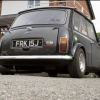Rear Toe In And Neg Camber
#1

Posted 08 December 2012 - 09:24 AM
I don't want to go crazy and I'm happy with standard ride height etc I just want a little of both.
Are there any generally regarded 'good' set ups?
Cheers.
#2

Posted 08 December 2012 - 09:31 AM
You can buy those which are only camber adjustable, and those which are both camber and toe.... however as a mini in standard configuration naturally has toe in at the rear, you can use spacers between the bracket and subframe to adjust this without the need for dual adjustable brackets...
As for what geometry setup is best then that all depends on what you are doing and also will need specialist set up..
Which is were I would suggest you talk to 'icklemini'
#3

Posted 08 December 2012 - 10:44 AM
I adjust the rear settings by filing the hole in the standard brackets or shimming behind the brackets as appropriate to give 1 mm to 2 mm toe-in and by filing the hole upwards to give zero to 0.5 degrees negative camber. Then wedge the suspension into place firmly and weld a large washer onto the bracket to hold the setting.
At the same time check the front-to-rear alignment. I use the old-fashioned method using two lengths of straight timber, 2" x 2", although I know I shall be told how a 4-way laser setter is the only proper way. How do you think we did it in the 60's? This was the only way and it still works fine.
#4

Posted 08 December 2012 - 10:55 AM
As has been said by Guess-works already, if you dont have the kit, get it set up by a professional, or an enthusiast who has the kit AND knows how to use it properly.
#5

Posted 08 December 2012 - 11:00 AM
Never used adjustable rear brackets myself.
I adjust the rear settings by filing the hole in the standard brackets or shimming behind the brackets as appropriate to give 1 mm to 2 mm toe-in and by filing the hole upwards to give zero to 0.5 degrees negative camber. Then wedge the suspension into place firmly and weld a large washer onto the bracket to hold the setting.
At the same time check the front-to-rear alignment. I use the old-fashioned method using two lengths of straight timber, 2" x 2", although I know I shall be told how a 4-way laser setter is the only proper way. How do you think we did it in the 60's? This was the only way and it still works fine.
or a piece of string around all four wheels...
to "GET THE WHEELS IN LINE"
#6

Posted 08 December 2012 - 11:06 AM
Or the two bits of 2 x 2 cable tied to the wheels and a tape measure can be used to check tracking as well as alignment.
I have been using old school methods since the sixty's, as has cooperman with no ill effect, but i just find this new toy so simple and quick to use, i wonder if we should all invest in one.
I still use many old school methods for diagnosis too, My son has recently had a three week issue trying to find a problem with his turbo conversion after a massive accidental overboost. I popped out oto him last night with a bit of rubber hose and he looked at me in disgust, then withing seconds, i found the problem. it was a leaky gasket at the plenum.
For those of you wanting to know what the hose was for, Ask Cooperman.
Edited by Yoda, 08 December 2012 - 11:22 AM.
#7

Posted 08 December 2012 - 11:15 AM
Actually you hold it on the bone just in front of yer lughole to be precice
Edited by Yoda, 08 December 2012 - 11:16 AM.
#8

Posted 08 December 2012 - 11:34 AM
If you have 4-way laser kit then, of course, use it. However, you can set a Mini suspension accurately without it - it just takes a lot more effort.
#10

Posted 08 December 2012 - 02:26 PM
For reference, my Mini is running 0.5º toe in at the rear and 0.5º negative camber. The negative camber is probably OTT. Vertical is best. I wouldn't set rear track as neutral nor toe-out unless I was a decent driver (I'm really not a good track driver). But as GW said it's all down to the car....and the application...and the driver.
The rear tracking is slightly trickier to set than the front. You're setting each wheel relative to the centerline rather than just relative to the opposite wheel. There seems to be some debate as to whether to use the centerline of the rear subframe or the centerline of the shell. to be honest I kinda did both and measured centre of the front subby, centre of the front axle and centre of the rear subframe's front and rear crossmembers. It's no real surprise that those lines didn't all perfectly coincide.
At the risk of hi-jacking I'd like to understand which centerline to use.
#11

Posted 08 December 2012 - 02:29 PM
#12

Posted 08 December 2012 - 02:47 PM
#13

Posted 08 December 2012 - 04:12 PM
#14

Posted 08 December 2012 - 04:35 PM
Edited by Yoda, 08 December 2012 - 04:35 PM.
#15

Posted 08 December 2012 - 04:36 PM
1 user(s) are reading this topic
0 members, 1 guests, 0 anonymous users


















